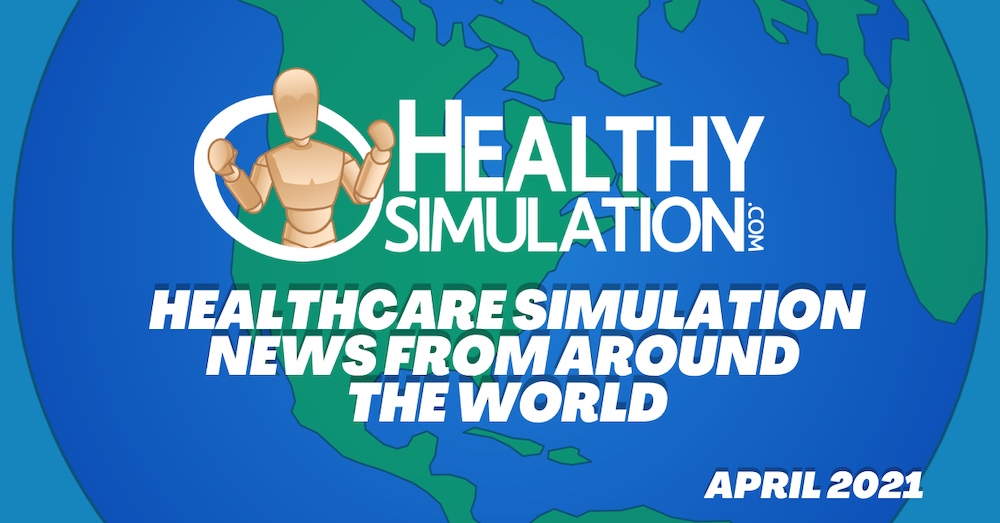Latest Clinical Simulation News From Around the World | April 2021
HealthySimulation.com helps clinical simulation educators, administrators and learners to stay up to date on industry topics through finding and sharing relevant news and information from around the world. This month’s healthcare simulation news updates include a new system of assessment and credentialing, technological innovations, learner-driven scenarios, behind-the-scenes 3D environments, simulation in critical care medicine data, software upgrades and more. Check out some of the world’s latest clinical simulation news by exploring the following updates:
B-Line Medical, Laerdal Medical Unify
To further work towards the vision to create the world’s premier debriefing, assessment and training management platform, Laerdal and B-Line Medical are unifying as one company. This will allow both SimCapture and Laerdal customers to streamline purchasing and support services to deliver the best training possible. The transition to unify both organizations was started shortly after Laerdal Medical acquired B-Line Medical in 2019. Since then, the companies have been working towards the end goal of coming together under one company name. Laerdal Medical has not set an end date for this transition. The company’s goal from the start was to take the best of the B-Line Medical and Laerdal organizations and create a unified path forward as one company.
Sponsored Content:
“Better training means better patient outcomes,” said Cindy Peters, Laerdal Medical’s director of marketing, North America. “All new product and company news will be communicated through Laerdal Medical social media channels. This will allow Laerdal Medical customers to get all their product news and announcements in a simpler more unified way.”
Additionally, the SimCapture team and B-Line Medical Washington, D.C., office is still part of Laerdal Medical. The SimCapture sales and services team unified under the Laerdal Enterprise Solutions team at the start of the year. This has allowed team members to operate as one team, helping provide solutions that are relevant and take healthcare simulation needs into account. SimCapture support and development will still be performed out of the former B-Line Medical Washington, D.C., office as part of the Laerdal Medical team. This change will allow customers to contact the same SimCapture support number and emails, but also to be able to contact their Laerdal support team to receive regional SimCapture support.
Cardionics, 3B Scientific Launch New Manikin
The companies Cardionics and 3B Scientific have launched Nikki the Nursing Manikin with Auscultation. This simulation manikin was developed for scenario-based clinical simulation to improve learners’ competency in patient care and advanced nursing skills. The manikin is a versatile solution for any program looking to educate learners on core patient care and nurse aide competencies while deepening auscultation skills with powerful, user-friendly technology.
Sponsored Content:
To achieve this level of education, the special training manikin features an extensive library of 42 premium-quality heart, lung and bowel sounds: 21 heart sounds, 15 lung sounds, and 6 bowel sounds. The product also features accurate auscultation sites (11 anterior and 4 posterior), and removable organs for O.S.C.E. skills training.
Nikki the Nursing Manikin with Auscultation is complete with NursingScope, an electronic simulation training stethoscope powered by Cardionics. Instructor control is available as well, so that educators can change sounds on the spot.
Northwestern University’s Simulation in Healthcare Education Podcast
In this podcast series, the team at the Northwestern University Feinberg School of Medicine focuses on key topics in healthcare simulation education. The first several podcasts focus on the book, Comprehensive Healthcare Simulation: Mastery Learning in Health Professions Education, published by the Northwestern Simulation team in 2020. Jeffrey Barsuk, MD, MS, leads the discussions by highlighting key issues about principles and practices of simulation-based mastery learning with chapter authors and book editors. Podcast listeners are free to reach out to the Northwestern Simulation team via email at simed@northwestern.edu.
SimGHOSTS Now Issues Digital Badges
SimGHOSTS has announced that the global nonprofit organization will now issue digital badges using the global OpenBadges format. Badges will be issued to those who have successfully completed the organization’s online courses, or those who have attended or presented at SimGHOST conferences. Recipients can register a free digital backpack to store and display all of the badges they collect from other OpenBadges issuers, and can download and display badges on their CV, social media accounts, SimGHOSTS member profile, and more.
Digital badging is a global system of assessment and credentialing that operates entirely online. A digital badge is a graphical representation of an achievement with embedded data that conveys to others who issued and received the badge, what the recipient did to earn the badge, standards that were met, and evidence of the achievement. According to SimGHOSTS, digital badging is ideal because they can help communicate and verify skill and knowledge acquisition to current or potential employers.
Canada’s National Virtual Simulation Project
Colleges and Institutes Canada, in partnership with Simulation Canada, has secured federal funding to develop innovative work-integrated learning opportunities to learners, through the collaborative development and distribution of virtual simulations for nursing, paramedicine and medical laboratory technology.
An upcoming call for expressions of interest will invite publicly supported colleges and universities to participate in the selection and development of approximately 120 virtual simulations. The call for expressions of interest will also offer publicly supported post-secondary institutions the opportunity to use the simulations created without participating in the development process. Project funding will cover release time for participating educators and simulation development costs. Learn more by requesting this recorded webinar.
VR Simulator Helps ASD Teens Learn to Drive
Amy Weitlauf, a psychologist at Vanderbilt University who specializes in autism, is collaborating with a team of Vanderbilt engineers to develop a special adaptive virtual reality driving environment for individuals with Autism Spectrum Disorders (ASDs). This is because there is growing agreement that individualized behavioral and educational interventions can have a positive impact on the lives of individuals with ASD and their families.
To achieve this goal, the team developed the Vanderbilt VR Adaptive Driving Intervention Architecture (VADIA). This technology is able to teach adolescents with ASD the basic rules of the road, while also gathering information about the unique ways that they react to driving situations. This data helps the system to identify when to alter driving scenarios, with varying degrees of difficulty, to provide users with the training they need while keeping them engaged in the process. The data can also potentially help screen for those whose deficits are too severe to drive safely.
During each driving simulation, participants are provided a headset containing electrodes that read the electrical activity of their brains as they are hooked up to an array of physiological sensors. The sensors record the electrical activity of the driver’s muscles (EMG), electrical activity of the heart (ECG), galvanic skin response, blood pressure, skin temperature and respiration. The elaborate monitoring allows the researchers to determine if the driver is engaged or bored by each simulation.
Laerdal Medical Introduces SimCapture Learner Driven Scenarios
With Laerdal Medical’s new SimCapture learner driven scenarios, simulation center educators can now deliver, monitor and track learners’ development of hands-on skills competence from anywhere. With this solution, learners have easy access to content and training scenarios right from their mobile devices. They can use the learner-driven scenarios in SimCapture Enterprise to practice skills together, or training can be reviewed and evaluated by their instructors.
This solution can also capture video from medical devices with VGA, DVI or HDMI output to get a full overview of clinical simulation activities. Other features include the ability for learners to debrief and evaluate their own sessions with mobile access to a dashboard and detailed reports, and enhanced patient safety using video capture, debriefing and safety checklists.
SimCapture enables medical schools, nursing schools and hospitals to deliver high-quality training, education and quality improvement programs. According to Laerdal, over 500 healthcare institutions in more than 35 countries currently use SimCapture to generate reports and statistics on performance and trends to improve administration, and to track usage and learning outcomes. As SimCapture is mobile-friendly, the solution can be employed anywhere and at any time.
‘The Mandalorian’ Uses Virtual Sets Instead of Green Screens
In this YouTube video, the global news publication Insider explains how LED walls are revolutionizing film and TV productions by projecting 3D environments in real-time behind actors to provide the illusion of being in a physical location. The video explains how these methods were put to the test on Disney’s “The Mandalorian,” of which over half was filmed indoors on a virtual set. The process of combining traditional cinematography techniques with advanced world-building technology effectively eliminates the need for a green screen when placing actors into new environments.
Simulation-Based Training Grows Rapidly in Critical-Care Medicine
Josef X. Brunner, the CEO at Neosim AG, shared a graph on LinkedIn demonstrating the rise in simulation in critical-care medicine publications from 1975 until the end of 2020. The graph demonstrates rapid growth in the number of these publications. Brunner downloaded the numbers and imported them into Excel directly from PubMed for display. He removed the 2021 data (232 publications) because coverage did not span a full year, just the first quarter. However, if he had extrapolated the 232 publications to the full 2021 year, the rising trend would continue.
On the company’s blog page, VRpatients explains how virtual reality is transforming education. According to Tom Cox, the Director of EMS Sales for VRpatients, learning in today’s world means “living in the environment and not sitting there reading a book.”
As for the pros of virtual training, this blog post notes that virtual reality provides learners with the ability to engage multiple senses in a three-dimensional computer-generated environment. VR can also place learners into real situations to see how they react, to walk learners through technical and complicated procedures and protocols to gain practice, and to help them practice dangerous situations without real consequences and risks. Therefore, the benefits of VR learning can be summarized to include simplification, safety, testing, analytics and distance.
On the contrary, VRpatients explains that the cons of virtual reality training can include a high cost to implement VR into current curriculum, and the risk of newer, improved equipment models launching soon after initial purchase. Another con is the lack of human interaction that can come with using VR and other technologies in educational settings. Other potential drawbacks of VR training include physical effects some people have when using virtual reality (e.g. vertigo, nausea, headaches, etc.)
Sim Café YouTube Channel
Simulation Australasia’s Sim Café YouTube channel includes a very rich set of resources. Viewers can explore speakers and varied topics – which all address some aspect of the multiple ways simulations and games are in use around the world.
As the Sim Café program evolves, more videos will be added to the channel. Members and friends of Simulation Australasia are invited to explore this rich trove of ideas. Contact Elyssebeth Leigh at Elyssebeth.leigh@icloud.com or Pip Lyndon-James at summercloud181@gmail.com for new ideas and suggestions for future topics. Members are especially invited to use this program as an opportunity to reach out to the simulation community to provide an hour of conversation about your projects, research and ideas.
The Brody Clinical Simulation Lab
The Brody School of Medicine’s Clinical Simulation Lab at East Carolina University promotes excellence in care through the application of safe, high-quality, clinical-simulation-based education. Here, learners are given faculty-guided instruction using computer programs; virtual reality simulators; innovative models; procedural task trainers; life-size, computer-enhanced patient simulators; simulated patients; and a self-directed learning component.
The Simulation Center is an integral part of the Brody School of Medicine curriculum. Within this program, each learner must participate in a minimum of 26 clinical simulation and skills sessions to graduate. There are also self-study opportunities for medical learners to aid in preparation for board exams, collaborate with simulation faculty for research initiatives, and gain hands-on practice in their areas of interest. The following YouTube video helps portray how learners experience hands-on training within the Brody Clinical Simulation Lab.
IngMar Medical Releases RespiSim Software 4.0
IngMar Medical has announced the release of an all-new release of the RespiSim Software Version 4.0. Designed by educators for educators, this new version has been built from the ground up and makes delivering effective mechanical ventilation training via high-fidelity, hands-on clinical simulation easier than ever before. Learners can use this software to step through pre-scripted medical simulation scenarios, or control parameters on the fly with a nearly unlimited number of patient conditions available at their fingertips.
“The focal point for that development effort has been to make the software as user-friendly and intuitive as possible for educators using simulation, while also maintaining the highly sophisticated, realistic patient-ventilator interactions produced by the system,” said IngMar Medical President Brian Linn.
In general, the RespiSim System for ventilator management training is a comprehensive system built around a realistic breathing simulator, the ASL 5000. Healthcare simulation educators can use the RespiSim System to conduct high-fidelity training in anesthesia, critical care, emergency medicine, pulmonology and respiratory care using their own real ventilators and respiratory devices.
‘Women in’ Unconference Series
Simulation Australasia, Unconference and the Women in Simulation interest group have created a new “Women in” Unconference series. Each Unconference is designed to focus on one of three exciting topics aimed to stimulate participants’ thinking and generate new ideas and solutions that will help them both professionally and personally.
The first event within this series was held on Wednesday, April 28 and discussed “Women in Regional and Remote Australia.” Participants heard from two women who have faced and overcome adversity and challenges as they worked in relatively isolated areas yet launched successful clinical simulation activities.
The next Unconference event will take place on Wednesday, May 26, and will focus on “Women in Leadership.” The event will highlight Women who have travelled the road to leadership and found strength as well as discovered insights as they progressed their career to the top. Following this event, the third part of the series will discuss “Women in Teams” on Wednesday, June 23. This brainstorming session will facilitate experts in teams to harness the collective “brain-bank.” The goal is to harness solutions relevant for different areas and situations.
UpSurgeon Launches New Technologies
The educational, academic and cognitive technology company, UpSurgeOn announced the launch of several new technologies in early April 2021. With the mission to support trainees and learners on their journey to become professionals with inspiring innovations, these new technologies include means for neuroanatomy study and neurosurgical training.
For example, the AnatomyTouch extends texture, color, consistency of the anatomical parts, having all been reproduced with extreme accuracy. The goal of this product’s launch was to allow the anatomy of the brain to finally be clearly separated from the brainstem and cerebellum. The AnatomyARt combines science, art, and augmented reality to inspire 3D-HD pieces of art from the UpSurgeOn library with Renaissance-style lighting. This product uses AR to transform art into scientific knowledge. Lastly, the Head Atlas is the first app available to the public with such a high degree of anatomical fidelity. This unprecedented level of detail is the result of a process called Scientific 3D modeling, a method able to deeply connect neuroanatomy experts with 3D artists.
EMS Mentioned by Forbes
In an article titled, “Fast Learner: How An Educational Software Firm Successfully Adapted To Pandemic Restrictions,” author Dustin Siggins shares how Education Management Solutions (EMS) overcome COVID-19 challenges. This included using a “Don’t Panic, Assess Risk, Seize Opportunity” plan. The article also shares how the company’s marketing team went digital yielding amazing results.
Microsoft Wins U.S. Army Contract for Augmented Reality Headsets
According to CNBC, Microsoft will deliver to the U.S. Army more than 120,000 devices based on the HoloLens augmented reality headsets. The deal, which could be worth as much as $21.88 billion over 10 years, follows a contract Microsoft received to build prototype headsets for the Army. The contract comes a year and a half after Microsoft won a cloud contract from the Pentagon that could be worth up to $10 billion. The standard-issue HoloLens, which costs $3,500, enables people to see holograms overlaid over their actual environments and interact using hand and voice gestures.
AppliedVR raises $29M, Seeks FDA Clearance of VR System for Pain Treatment
According to MedCity News, AppliedVR raised $29 million in funding to pursue FDA clearance of a virtual reality platform for pain relief. The Los Angeles-based startup is developing a digital therapeutic to treat chronic pain using VR. AppliedVR is designing self-guided courses with mindfulness exercises and pain education, rather than focusing on VR as a physical therapy tool. The company received a breakthrough device designation from the FDA last year, and recently shared results of a pivotal trial that it plans to submit to the regulator. In a randomized, controlled trial, AppliedVR found that the company’s eight-week program resulted in a 42% reduction in pain intensity for people with chronic lower-back pain.
Subscribe for More of the Best Medical Simulation Updates!
Lindsey Nolen is the Content Director for HealthySimulation.com. She is an award-winning journalist with years of experience writing about the many different facets of healthcare, including clinical simulation education and training. She also helped create content for the healthcare career information website, CareersinHealthcare.com.
Sponsored Content:
















